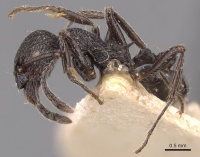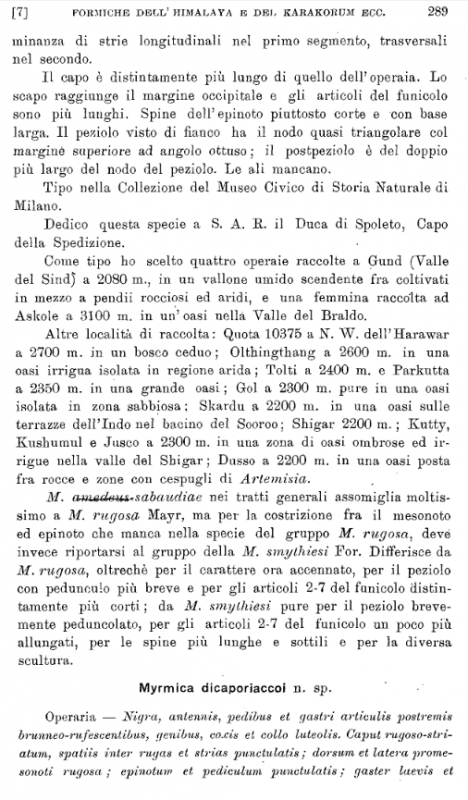Myrmica aimonissabaudiae
| Myrmica aimonissabaudiae | |
|---|---|

| |
| Scientific classification | |
| Kingdom: | Animalia |
| Phylum: | Arthropoda |
| Class: | Insecta |
| Order: | Hymenoptera |
| Family: | Formicidae |
| Subfamily: | Myrmicinae |
| Tribe: | Myrmicini |
| Genus: | Myrmica |
| Species: | M. aimonissabaudiae |
| Binomial name | |
| Myrmica aimonissabaudiae Menozzi, 1939 | |
| Synonyms | |
| |
This species has a widespread distribution in Himalaya, occupying a variety of habitats, under stones, rotten wood, near the foot of trees, riverine habitats and nests in open meadow mostly in Pinus, Cedrus and Juniperus forests. The nests of this species are polydomous, with the internal temperature ranging from 14°C to 28°C, and thrive well in disturbed habitats with considerable anthropogenic activities. Large nests were observed to contain more than 200 workers including alates (both males and gynes) were observed in June and as late up to first week of August. The altitudinal range for the species in Himalaya is 1300m to 3500m above mean sea level. (Bharti et al., 2016)
A little more is known about the ecology of M. aimonissabaudiae compared to most other Himalayan species because it appears to be one of the most common, based on published data and material in collections. It has been found at quite a range of altitudes, 1300 to 3450 m (most of Menozzi's material was collected between 2200 m and 2600 m), in both natural and disturbed habitats. The latter includes fields and parks where it prefers relatively wet places being quite common in irrigated fields; Menozzi (1939: 289) particularly mentions that it was found near oasi in the middle of quite arid regions. More recent records suggest that M. aimonissabaudiae is most abundant in semi-natural habitats where nests have been found in open grasslands with or without shrubs, and in deciduous and coniferous forests, where it nests both in the ground and in rotten wood (Philip Ward, pers. comm.). Based on these reports it appears to occupy a niche similar to that of Myrmica ruginodis in Europe.
Identification
A member of the rugosa complex of the rugosa species group. It most resembles two other Himalayan species – Myrmica rugosa and Myrmica hecate - particularly by the distinct (but not coarse) sculpture on the nodes of the petiole and postpetiole. However it differs from the former by having much better developed reticulation on the head dorsum, and from the latter by its less multidentate mandibles (7-9 teeth on the masticatory margin of mandibles vs. > 10 in M. hecate). (Radchenko and Elmes 2010)
Keys including this Species
Distribution
NE Afghanistan, NE Pakistan, India: Kashmir, Himahal Pradesh, West Bengal (Darjeeling), Sikkim, Meghalaya; Nepal, Bhutan.
Latitudinal Distribution Pattern
Latitudinal Range: 35.5439° to 28.683333°.
| North Temperate |
North Subtropical |
Tropical | South Subtropical |
South Temperate |
- Source: AntMaps
Distribution based on Regional Taxon Lists
Oriental Region: Bhutan, India, Nepal, Pakistan (type locality).
Palaearctic Region: Afghanistan.
Distribution based on AntMaps
Distribution based on AntWeb specimens
Check data from AntWeb
Countries Occupied
| Number of countries occupied by this species based on AntWiki Regional Taxon Lists. In general, fewer countries occupied indicates a narrower range, while more countries indicates a more widespread species. |

|
Estimated Abundance
| Relative abundance based on number of AntMaps records per species (this species within the purple bar). Fewer records (to the left) indicates a less abundant/encountered species while more records (to the right) indicates more abundant/encountered species. |

|
Biology
This species is host to two inquilines, Myrmica ereptrix and Myrmica latra.
It is also known to tend the aphids Aphis fabae, Chaetosiphon (Pentatrichopus) glabrum, Cinara confinis and Cinara orientalis in Pakistan (Gull-E-Fareen et al., 2020).
Castes
Nomenclature
The following information is derived from Barry Bolton's Online Catalogue of the Ants of the World.
- aimonissabaudiae. Myrmica aimonissabaudiae Menozzi, 1939a: 286, figs. 1, 3 (w.q.) PAKISTAN. Collingwood, 1961a: 56 (m.). Senior synonym of dicaporiaccoi: Radchenko & Elmes, 2001a: 248. [Misspelled as amedeussabaudiae by Menozzi, 1939a: 286.] See also: Radchenko & Elmes, 2010: 82.
- dicaporiaccoi. Myrmica dicaporiaccoi Menozzi, 1939a: 289, figs. 5, 6 (w.) PAKISTAN. Junior synonym of aimonissabaudiae: Radchenko & Elmes, 2001a: 248.
Type Material
Myrmica aimonissabaudiae
- Lectotype of (designated by Radchenko & Elmes, 2001): worker, “Karakorum, Gund, Valle Sind, 2080m, 9.iv.1929” (MSNM).
- Paralectotypes (designated by Radchenko & Elmes, 2001): 3 workers, “Karakorum, Gund, Valle Sind, 2080m, 9.iv.1929” (MSNM); 1 gyne, “Askol, Braldo, 3100m, 10.viii.1929” (MSNM).
Myrmica dicaporiaccoi
- Lectotype of (designated by Radchenko & Elmes, 2001), worker, “Sped. Karakorum, Shigar, 23.viii.29, 2200m” (MSNM).
Unless otherwise noted the text for the remainder of this section is reported from the publication that includes the original description.
Description
Worker
Etymology
Radchenko and Elmes (2010) - the name derives from the first name Aimone combined with Sabaudi (meaning Savoyan). It is dedicated to the leader of the Italian Expedition to the Karakorum, 1929, which collected the type material.
References
- Bharti, H., Radchenko, A. and S. Sasi. 2016. Socially-parasitic Myrmica species (Hymenoptera, Formicidae) of Himalaya, with the description of a new species. ZooKeys. 605:113–129. (doi:10.3897/zookeys.605.9087).
- Bharti, H., Sasi, S., Radchenko, A. 2016. Biogeography and ecology of Myrmica species (Formicidae: Myrmicinae) in Himalayan regions. Sociobiology 63, 956-975 (DOI 10.13102/sociobiology.v63i3.1145).
- Collingwood, C. A. 1961a [1960]. The third Danish Expedition to Central Asia. Zoological Results 27. Formicidae (Insecta) from Afghanistan. Vidensk. Medd. Dan. Naturhist. Foren. 123: 51-79. (page 56, male described)
- Dendup, K.C., Dorji, C., Dhadwal, T., Bharti, H., Pfeiffer, M. 2021. A preliminary checklist of ants from Bhutan. Asian Myrmecology 14, e014005 (doi:10.20362/am.014005).
- Gull-E-Fareen, A., Bodlah, I., Rasheed, M. T., Niaz, Y., Bodlah, M. A., Asif, M., Khokhar, N. M. (2020). Trophic associations of ants with aphid partners and new distribution records of some ants in Pothwar Region of Pakistan. Pakistan Journal of Zoology, 531 (doi:10.17582/journal.pjz/20190510120507).
- Menozzi, C. 1939a. Formiche dell'Himalaya e del Karakorum raccolte dalla Spedizione italiana comandata da S. A. R. il Duca di Spoleto (1929). Atti Soc. Ital. Sci. Nat. Mus. Civ. Stor. Nat. Milano 78: 285-345 (page 286, figs. 1, 3 worker, queen described)
- Radchenko, A. G.; Elmes, G.W. 2001b. A taxonomic revision of the ant genus Myrmica Latreille, 1804 from the Himalaya (Hymenoptera, Formicidae). Entomol. Basil. 23: 237-276 (page 248, Senior synonym of dicaporiaccoi )
- Radchenko, A.G. & Elmes, G.W. 2010. Myrmica ants of the Old World. Fauna Mundi 3: 1-789.
- Rasheed, M.T., Bodlah, I., Fareen, A.G., Wachkoo, A.A., Huang, X., Akbar, S.A. 2019. A checklist of ants (Hymenoptera: Formicidae) in Pakistan. Sociobiology 66(3), 426-439 (doi:10.13102/sociobiology.v66i3.4330).*Subedi, I.P., Budha, P.B., Bharti, H., Alonso, L. 2020. An updated checklist of Nepalese ants (Hymenoptera, Formicidae). ZooKeys 1006, 99–136 (doi:10.3897/zookeys.1006.58808).
References based on Global Ant Biodiversity Informatics
- Bharti H., S. Sasi, and A. Radchenko. 2016. Biogeography and ecology of Myrmica species (Formicidae: Myrmicinae) in Himalayan regions. Sociobiology 63(3): 956-975.
- Bharti H., Y. P. Sharma, M. Bharti, and M. Pfeiffer. 2013. Ant species richness, endemicity and functional groups, along an elevational gradient in the Himalayas. Asian Myrmecology 5: 79-101.
- Collingwood C. A. 1961. The third Danish Expedition to Central Asia. Zoological Results 27. Formicidae (Insecta) from Afghanistan. Videnskabelige Meddelelser fra Dansk Naturhistorisk Forening 123: 51-79.
- Jansen G., R. Savolainen, K. Vespalainen. 2010. Phylogeny, divergence-time estimation, biogeography and social parasite–host relationships of the Holarctic ant genusMyrmica(Hymenoptera: Formicidae). Molecular Phylogenetics and Evolution 56: 294-304.
- Mani M. S., and S. Singh. 1962. Entomological survey of Himalaya. Journal of the Bombay Natural History Society 59(1): 84-85.
- Menozzi C. 1939. Formiche dell'Himalaya e del Karakorum raccolte dalla Spedizione italiana comandata da S. A. R. il Duca di Spoleto (1929). Atti della Società Italiana di Scienze Naturali e del Museo Civico di Storia Naturale di Milano. 78: 285-345.
- Pisarski B. 1967. Ameisen (Formicidae) von Dr. J. Klapperich in Afghanistan gesammelt. Polskie Pismo Entomologiczne 37: 47-51.
- Radchenko A. G., and G. W. Elmes. 2001. A taxonomic revision of the ant genus Myrmica Latreille, 1804 from the Himalaya (Hymenoptera, Formicidae). Entomologica Basiliensia 23: 237-276.
- Radchenko A. G., and G. W. Elmes. 2010. Myrmica ants (Hymenoptera: Formicidae) of the Old World. Fauna Mundi 3. Warsaw: Natura Optima Dux Foundation, 790 pp.
- Radchenko, A. G., and G. W. Elmes. "A taxonomic revision of the ant genus Myrmica Latreille, 1804 from the Himalaya (Hymenoptera: Formicidae)." Entomologica Basiliensia 23 (2001): 237-276.
- Rasheed M. T., I. Bodlah, A. G. Fareen, A. A. Wachkoo, X. Huang, and S. A. Akbar. 2019. A checklist of ants (Hymenoptera: Formicidae) in Pakistan. Sociobiology 66(3): 426-439.
- Weber N. A. 1947. A revision of the North American ants of the genus Myrmica Latreille with a synopsis of the Palearctic species. I. Annals of the Entomological Society of America 40: 437-474.
- Pages using DynamicPageList3 parser function
- North temperate
- North subtropical
- Ant Associate
- Host of Myrmica ereptrix
- Host of Myrmica latra
- Aphid Associate
- Host of Aphis fabae
- Host of Chaetosiphon (Pentatrichopus) glabrum
- Host of Cinara confinis
- Host of Cinara orientalis
- Species
- Extant species
- Formicidae
- Myrmicinae
- Myrmicini
- Myrmica
- Myrmica aimonissabaudiae
- Myrmicinae species
- Myrmicini species
- Myrmica species
- Ssr





